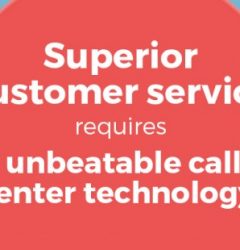
Good customer service is essential for any business. It can make or break a customer’s experience with your company, and it can be the deciding factor in whether or not they come back. In this article, we will list 16 customer service tips that are actually helpful. We’ve gathered these tips from our own personal experiences as well as from customer service experts. Keep reading to learn more!
1. Answer the Phone Promptly (and Use the Right Tools!)
One of the most important customer service tips is to answer the phone promptly. When a customer calls, they want to speak with someone as soon as possible. If they have to wait on hold for a long time, they will likely become frustrated and hang up.
If you can’t answer the phone right away, have a message stating how long the customer can expect to wait. And make sure to keep your promise!
If you’re unable to take their call, have a good phone system that provides an option for customers to leave a message. You can also use an automated phone answering software to route calls to the appropriate department or employee.
💡 Tip: Avoid putting customers on hold for too long. If you need more than a minute or two to gather information or speak with another person, let them know and offer an estimate of when they will be able to speak with someone.
2. Speak to Your Customers in Their Language
One of the best ways to provide good customer service is to speak to your customers in their language. This means using the same words and phrases they would use, and speaking at a similar pace.
By speaking to them in their language, you can sound closer to them and make them feel more comfortable.
If you’re not sure what words to use, try asking a colleague or friend for help.
💡 Tip: Avoid using complex jargon or industry terms unless you’re absolutely certain that your customer will understand them.
3. Use Positive Language
The tone of your voice can have a big impact on customer service. Avoid using negative language and framing, which can make customers feel anxious or frustrated.
Instead, use positive language and framing to put the customer at ease. For example, if you need to delay a delivery, frame it in a positive way by saying that you’re working hard to get it to them as soon as possible.
👉 Positive example: “We’re working hard to get your order to you as soon as possible.”
👉 Negative example: “Your order is going to be delayed.”
💡 Tip: Frame any bad news in a positive light. This will help soften the blow and make the customer feel like you’re doing everything you can to help them.
4. Automate What You Can
One way to improve customer service is to automate as much as you can. This means using chatbots and other self-service tools and resources.
Chatbots are automated programs that can help customers with common tasks, such as checking the status of an order or finding information about a product.
Self-service tools and resources allow customers to find the answers they need without having to speak with a representative. This can be helpful for simple tasks, such as finding shipping information or product specifications.
When Would Chatbots & Self-Service Resources Be Appropriate?
They are a great way to provide good customer service when it’s not possible for a representative to answer the phone. For example, if it is outside working hours, or if the representative is busy with another call.
By using these self-service tools, you can provide good customer service around the clock.
When Would Chatbots & Self-Service Resources Not Be Appropriate?
They are not appropriate for complex tasks or inquiries. If the customer needs help with something that is beyond the chatbot’s capabilities or not included in the resources, they will need to speak with a representative.
Additionally, chatbots should not be used in place of human interaction. They are best used as an extension of customer service, rather than a replacement.
5. Make Sure You’ve Resolved the Issue
One of the best ways to provide good customer service is to make sure you’ve resolved the issue now, during the call. Don’t leave it for later.
By resolving the issue now, you can prevent it from becoming a bigger problem down the road. You can also avoid having to deal with multiple calls about the same issue.
👉 Example: “I’m sorry we were unable to send your order on time. I’ve refunded your shipping charges and we’ll get your order out as soon as possible.”
👉 Example: “I understand that you’re upset about your order. Let me help you resolve this issue so that you’re happy with your purchase.”
6. Don’t Forget Customers Don’t Have the Same Knowledge as You Do
When you’re dealing with customers, it’s important to remember that they don’t have the same knowledge as you do.
This means that they might not know about your company, products, or industry terms. It also means that they might not understand complex concepts or processes.
This can be frustrating for agents, but it’s important to remember that the customer is not trying to be difficult. They’re just looking for help.
If you’re not sure whether a customer understands a term, explain it in simpler terms. You can also ask the customer if they have any questions about what you’ve said.
7. It’s Okay to Say “I don’t know”
When you don’t know the answer to a customer’s question, it’s okay to say so.
This will help the customer understand that you’re not trying to hide anything from them and that you’re willing to help them find an answer.
It also shows that you’re taking their inquiry seriously and that you want to resolve the issue.
💡 Tip: Try one of these methods if you don’t have an answer for a customer but want to provide some form of assistance:
- Search for an answer using internal resources or Google.
- Escalate the inquiry to a supervisor or manager.
- Offer to call the customer back once you have an answer.
8. Make Sure Customers Understand What You Mean
When you’re speaking with a customer, it’s important to make sure that they understand what you’re saying.
If you think the customer didn’t understand something, ask them if they have any questions.
👉 Example: “Are you asking about our return policy? We accept returns within 30 days of purchase.”
👉 Example: “I’m sorry, I don’t understand your question.”
9. Practice Mimicking
One of the best ways to provide good customer service is to use mimicry and active listening.
Mimicking helps you understand the customer’s needs and shows that you’re taking their inquiry seriously. It also makes the customer feel heard and understood.
Active listening involves paying close attention to what the customer is saying and asking questions to clarify anything that you don’t understand. This will help ensure that both you and the customer are on the same page.
By using these techniques, you can resolve issues quickly and effectively.
To practice mimicking:
Start by repeating what the customer has said, using the same words and tone of voice.
Next, paraphrase what the customer has said in your own words to make sure that you understand them correctly.
To practice active listening:
Start by paying close attention to what the customer is saying and asking questions to clarify anything that you don’t understand. This will help ensure that both you and the customer are on the same page.
10. Don’t Be Too Formal
It’s important to find the balance between a formal business conversation and a personable conversation. When speaking and writing to customers, it needs to be professional concerning the wording and content, however, it also needs personal touches. The customer wants to feel as though they can rely on the company, while at the same time feel important to the company.
💡 Tip: Try to mirror the way the customer talks and interacts with you. Mirroring someone builds trust and makes the sales pitch more persuasive.
11. Admit Your Mistakes
Mistakes are inevitable, they are going to happen every now and again. The key here is to be transparent with the customer and admit the mistake. Customers are much more likely to be understanding and calm if the agent owns up to the mistake. This will diffuse the situation and allow the agent to help the customer in resolving the issue at hand.
👉 Example: “Hello Mr. Brown, I understand you are upset about your card being charged the wrong amount. It was my mistake. I am sorry for any trouble it might have caused. Please allow me to fix the issue and help to get this resolved.”
12. Pay Attention to Feedback
Feedback is highly valuable. It provides information about issues within the company or about the product. It also provides information about what the company is excelling at. It is a valuable tool that can be used to help change the company’s methods and provide better service.
Having agents pay close attention to feedback will increase the company’s chances of producing more customers and producing more satisfied customers. Furthermore, it’s important to let the customers know that their opinions are valuable and that the company does hear them.
13. Manage Expectations
Companies tend to make promises that they can’t deliver on. You might have experienced this yourself. It can be frustrating to say the least when you have an expectation based on what the company portrays and then it falls short.
Agents should never put their customers through this disappointment. It is always best to be honest about what the product/service offers and to be truthful about all other aspects, so the customer knows exactly what to expect.
💡 Tip: Many salespeople create high expectations for the product they are selling and it might work for getting that initial sale, but it doesn’t always produce a satisfied customer. You don’t want to have to face chargebacks, bad reviews, or negative word-of-mouth marketing. Always give realistic expectations.
14. Address Customers Personally
The oldest trick in the book to make a personable customer service experience is by using the customer’s name when talking with them, emailing, etc. This is a way that makes the conversation more friendly, while not overdoing it.
💡 Tip: Find a Power Dialer that will allow you to state the customers name before sending a pre-recorded voicemail message.
15. Don’t Be Generic, Be Human
There are a lot of ways that the customer can come into contact with a business. There are live chats, emails, SMS, telephone calls, and social media. All of which have the opportunity to make a good impression or a not-so-good impression with the customer.
Because most consumer to business communication is through technology it is vital that agents go the extra mile to make the interaction personable. Remember, there is no body language and often no tone of voice that they can hear to determine the agent’s attitude or intentions. Knowing this, agents must be selective with their word choices and leave no room for doubt on what kind of message you are trying to send.
Example of a generic response (Live Chat):
Hello, what could we help you with?
Example of a human/personable response (Live Chat):
Hi, this is Kailey, please let me know if there is anything I can help you with.
With the customer service tips in mind, let’s get into the 7 ways to build a customer service strategy!


